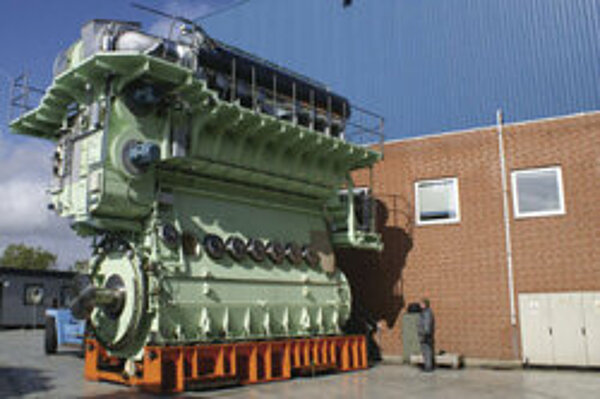OELCHECK SDA analysis service for 2-stroke diesel ship engines

Table of contents
- OELCHECK SDA analysis service – for optimum engine management
- Full speed ahead – with OELCHECK SDA lubricant analyses
- The SDA laboratory report – Matrix for all (up to 12) cylinders
- Medium-term trends – already seen in the first year
- Long-term trends – You are the one who benefits from it the most
- OELCHECK SDA laboratory reports provide an excellent overview of:
- SDA analysis sets – practical, cost-effective and used worldwide
- Faster access to all laboratory reports with the online database
- An SDA oil analysis set contains:
OELCHECK SDA analysis service – for optimum engine management
In the marine sector, oil can now speak even more clearly! OELCHECK deciphers the message of oil – and along with the all important lubricant itself, accurate conclusions can be drawn about the state of individual cylinders in 2-stroke engines through a new, clear evaluation of the analysis results. The "OELCHECK system", with tailor-made and thus more cost-effective analytical sets for almost every issue, is unique. OELCHECK now offers a significantly expanded and, of course, globally usable analysis service for the "Scrape-Down Oil Analysis" (SDA) of slow-speed 2-stroke diesel engines in which, after a short period, the cylinder oil is exhausted and is lost.
The 2-stroke marine diesel in particular, with an output of over 100,000 HP, is a hard worker with plenty of stamina. These are mostly operated with HFO (heavy fuel oil). Its quality not only varies constantly but it is also contaminated, above all, with sulphur. Then there are also impurities, such as water, salt, nickel, vanadium and cat-fines. These fine-grained aluminium and silicone compounds have an abrasive effect like that of sand. They originate from the treatment of the HFO with a catalyst which is called cat-fines.
HFO fuel and its fluctuating feed rates that depend on its quality pose a constant challenge for engines and their lubrication. The volume of lubricant, which is provided for each cylinder with an individually set dosing pump, needs to be continuously adjusted for the fuel and the operating conditions of the engine. The more sulphur the fuel contains, the higher the concentration of additives needs to be to neutralise the sulphuric acid and the combustion residues.
In order to determine how heavily contaminated the lubricating oil is and whether more or less should be fed in, the cylinder oil running down from the liner is analysed with rapid test equipment, often on board the ship itself.
At times when engines are only operating at partial load due to slow steaming, condensation occurs in the engine, causing corrosion which will deteriorate further if insufficient lubricant is supplied, but will not improve by adding too much engine oil.
Sampling point for SDA oil tests
To ensure that the main engine of a ship works reliably and efficiently over several years and for well over one hundred thousand hours of operation, even under extremely unfavourable operating conditions, it requires excellent maintenance and effective control mechanisms. If the injection of the heavy fuel oil can also be optimised as part of the engine management, along with optimised feed rates for cylinder oil, the immense operating costs can be significantly reduced.
After all, a large, slow-speed 2-stroke diesel engine requires up to 25 tonnes of HFO fuel per cylinder per day. Moreover, large ship engines consume up to 2,000 litres of cylinder oil per day with their 12 or even 14 cylinders.
Full speed ahead – with OELCHECK SDA lubricant analyses
Maritime shipping is the largest carrier of traffic in the global economy. Most large freighters, tankers and container ships are driven by slow-speed 2-stroke diesel engines. These engines are often over 30m long and around 13m high. They have a power output of 3,500kW to 80,000kW and between 5 and 14 cylinders. The slow-speed engines operate at 40 to 160 rpm and do not require any expensive gearboxes. Their power output is transmitted directly to the propeller, and the engine can be operated forwards and also in reverse.
Mostly, HFO (heavy fuel oil) is used as the fuel. It is produced mainly from residues of mineral oil processing, and is so viscous that it needs to be heated in storage and particularly before combustion. Although some impurities are already removed from the pre-heated fuel by centrifuges and filtering, the heavy oil remains contaminated with sulphur compounds and metals. This is an immense challenge for any slow-speed 2-stroke diesel engine, which requires two different types of oils in order to operate.
- Large ship engines consume up to 2,000 litres of cylinder oil per day. This oil is pumped directly into each individual cylinder using a central lubrication pump. This very highly viscous oil, generally SAE 50 cylinder oil, must not only lubricate, but primarily it must protect the components from corrosive wear by neutralising combustion residues. It has a high alkalinity reserve (BN), and thus neutralises the aggressive effect of the acids resulting from the combustion of sulphur. If this reserve or the base number (BN) of the lubricant decreases too far, the door is opened to corrosion and wear. This is why cylinder oils are monitored on board using rapid tests and, above all, are thoroughly examined in the laboratory. Oil samples are obtained by collecting oil residues as „scrape down“ or „drip oil“. The results from the laboratory then provide information about the state of the oil and the cylinders. In addition, the dosage of lubricating oil can be optimised using SDA analyses for the individual cylinders.
- The connecting-rod bearings and all other moving parts are lubricated by a complex circulation system, using an SAE 30 (or SAE 40 for stationary engines) system oil with a base number of approx. 6mgKOH/g. This system oil is also used as hydraulic oil for control systems and as coolant for piston cooling in most engines. The system for engine lubrication takes more than 50,000 litres for large engines. The system oil is rarely changed completely. A partial change of a maximum of 50% only ever takes place depending on oil analyses, as well as replenishing losses. The oil analyses also provide information about e.g. how much fuel or cylinder oil has contaminated the system oil through leakage.
As the main power source, the 2-stroke engine is the heartbeat of a ship. It is also often relied upon to generate base-load electricity and supply hot water. There are countless other machines and systems on board that need to be supplied with lubricants. These include, for example, the 4-stroke diesel engines of the generators, compressors, pumps, winches and cranes, lift hydraulics and other hydraulic systems. The lubricating oils and greases in these power units are also monitored reliably using OELCHECK analyses.
The SDA laboratory report – Matrix for all (up to 12) cylinders
The SDA laboratory report – Matrix for all (up to 12) cylinders

The OELCHECK SDA laboratory report is a compact dataset instrument showing complete details for all cylinders. Even at first glance, it is clear whether and where action needs to be taken. A matrix provides information about the state of the cylinder oils, the lubricant feed rate in each cylinder, additives and alkalinity reserve, viscosity and abrasion, as well as other impurities such as cat-fines, water, soot, silicon and metals such as nickel and vanadium. Under a separate heading, the values for iron particles, chrome, copper and the PQ index (value for magnetic iron particles) are shown as important indicators of any wear. Diagrams can illustrate the results of the studies as a trend line. An experienced tribologist proposes further measures in an individual comment. If these instructions are implemented on board, they contribute substantially to the cost-effective and reliable operation of the engine.
Medium-term trends – already seen in the first year
The informative laboratory reports are prepared in a clear and well structured form. They contain not only the data for the current samples, but also the values of up to the four previous examinations. This provides the user with a basic overview of the operation of the engine and the performance of the cylinder oil. Since up to five SDA analyses a year are performed, the individual cylinders can be compared very easily using the trend analyses.

The OELCHECK SDA analyses that should be performed every two to three months are an indispensable addition to the sensors and rapid tests on board. A clear laboratory report is now available with new, significantly extended data, which provides a comprehensive overview of the state of all cylinders at a glance. In addition, any necessary corrections to the lubricating oil feed rate can be ascertained from it immediately and clearly.
Long-term trends – You are the one who benefits from it the most

The efficient operation of a ship and hence the profit generated by the owner depend on the reliable operation of the main 2-stroke engine, which directly drives the propeller. With the SDA laboratory reports by OELCHECK:
- you can recognise long-term trends and take timely countermeasures.
- you can optimise the cylinder oil feed rate
- you can detect impending damage in good time
- you can schedule maintenance work in advance
- you can avoid unnecessary costs and any outages.
The laboratory reports also allow conclusions to be drawn about the quality of the fuel used, with its varying sulphur content and the amount of lubricating oil required for it. Under MARPOL regulations, HFO may contain up to 3.5% or 35,000mg/kg of sulphur. If a scrubber is installed, these values may even be exceeded. Combustion of HFO, including its sulphur content, gives rise to aggressive acids. To neutralise these, the cylinder oils must have a high alkalinity reserve. To date, SAE 50 cylinder oils with a base number (BN) of 70 (alkalinity reserve of 70mgKOH/g) have mainly been used. For a HFO with a low sulphur content (less than 1.5%), oils with a base number of 40 have also been used. Cylinder oils are now available in additional viscosities and with higher base numbers (up to 100). Furthermore, cylinder oils with a lower BN (around 15 to 20) are currently being introduced for use with diesel fuel with a low sulphur content.
This "environmentally-friendly diesel" must be used in ECA waters from 1 January 2015.
Whichever cylinder oil is used, though, all values in combination and considered over a longer period enable optimum engine management in the long term.



